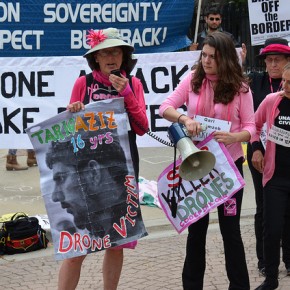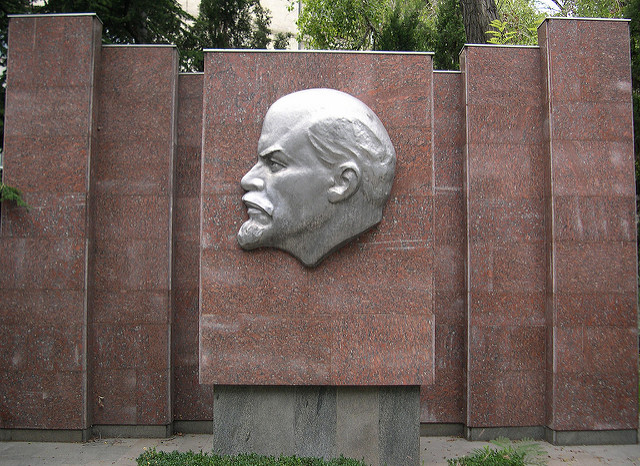Nadya Sadoeva owns Dimitrov. Well, the concrete bust of him anyway. The village of the same name, formerly known as Koilasar, lies in Armenia’s Ararat Province, not far from the regional centre of Artashat. I’ve visited this region of Armenia several times over the past few months in my research into the country’s Assyrian community. The face of a Bulgarian Communist revolutionary, Georgii Dimitrov has become a familiar, even comforting, sight when leaving the Marshrutka from the capital. Leave the bus stop, greet Georgii, and face towards a small blue road sign pointing towards Yerevan (strangely, written entirely in English,) and you have arrived at Nadya’s cinema.
Cinema Dimitrov is also a familiar sight. I’ve walked past it many times on my way to the village centre, towards the Russian Orthodox Church, St. Kyriakos, where 60-year-old Dimitrov native Nadya can often be found. I get a couple of friendly waves. In nearly monoethnic Armenia, the 2,769 strong Assyrian community is one of a handful of ethnic minorities, and Dimitrov is one of their earliest settlements. Accepting Russian Orthodoxy after their settlement in the Caucasus following the Treaty of Turkmenchai in 1828, the forebears of Armenia’s Assyrians came mostly from Urmia, in Northwestern Iran. Assyrians in Armenia enjoy excellent relations with their Armenian neighbours – and indeed, family members, as mixed marriages are commonplace here. Most of Armenia’s Assyrians Russified their surnames following their conversion to Orthodoxy, the Bit-Sado family becoming the Sadoevs.
As in many villages in Armenia, the results of emigration and a struggling rural economy are visible in Dimitrov. After the kitschy roadside casinos on the outskirts of Yerevan, empty buildings are a commonplace sight along the Artashat road. There’s one abandoned cognac factory (and thankfully, two operational ones) near Byuravan and an abandoned Soviet restaurant on a hill overlooking Yerevan’s Malatia-Sebastia district (sometimes known to locals as Bangladesh.) “When Nazarbayev took power in Kazakhstan,” complained one Artashat resident, “he kept the factories open – people kept their jobs as under Communism. Why couldn’t that happen here? Why didn’t that happen here?” The Karabakh War? The excesses of post-Soviet privatisation? Both?
In 1966, one enterprising Assyrian comrade from Dimitrov, Georgii Isaevich, requested that the authorities of the Armenian SSR construct a cultural centre in his native village. A two-story one, at that, including a disco, bar, youth club and cinema. At seven hundred metres squared, it dwarfed the old club for the Dimitrov collective farm which had previously stood there. The club was a success. Even though, Nadya points out, the town of Artashat was the administrative centre of the region, Dimitrov got to watch the newest films from Yerevan – Russian, Armenian, even Indian (with subtitles, of course.) That Dimitrov is in fact closer to Yerevan than is Artashat was irrelevant. These villagers enjoyed the finest, and they enjoyed it first. With the collapse of the Soviet Union, the film reels stopped spinning. Karabakh erupted, fortunes faded and the cinema’s along with them. After all, adds Nadya “Who goes to the cinema when you can’t afford bread?” They could have gone dancing in the disco. Nobody did that either. The rhythms had changed somewhat.
In summer 1996, Nadya Sadoeva with the support of her brother Grigorii purchased the building in a government auction. Birthdays and holidays were celebrated, as well as a one-off festival of national songs, Armenian, Assyrian, Azerbaijani, Russian, and Ukrainian. Nadya sang and her brothers- all musicians- played, and Assyrian guests came from Sweden to hear them. Yet these events were exceptions. The building, with its fine acoustics, has largely remained unused. The silence is deafening.

The Sadoevs are a family of music makers. Literally so, as a visit to Andrei and Misha Sadoev’s workshop in Yerevan will show. Misha is recognised as one of Armenia’s finest craftsmen of two traditional woodwind instruments, the Duduk and Zurna, whilst Andrei makes traditional string instruments. Accordingly, Nadya’s plans for the building were ambitious. There was to be an art gallery, café, cinema and restaurant. The space is there, but finding the money – and young people in Dimitrov to use it – is more difficult.

Cinema Dimitrov and the land surrounding it (hence, Georgii Dimitrov’s statue) are for sale. Some prime Armenian-Assyrian real estate, ‘with a view of Ararat from its upper balcony’, Nadya adds (though there are no buyers yet.) She unlocks the enormous padlock and pulls the metal doors towards her and we make our way into the gloom. “Karate,” spell out Cyrillic letters over one of the windows – one of the many short term uses of the building over the past twenty years. Disco, Dojo, Cinema, Bar, Concert Hall.
It’s sparse inside. The electric circuits need rewiring and we have brought a torch. Echoes and beams of light ricochet over the peeling wallpaper. An Armenian flag drips, unceremoniously from the ceiling. It doesn’t seem to intend to stay there for much longer. The interior of the cinema is immense given the village it served. There’s a new screen inside, and the Soviet-era cameras are still in working order. The cinema’s roof is in good condition too. Clearly there are opportunities here for those with the means to realise them. We climb the stairs to the projection booth. Ageing film posters cover the walls – Brod, a 1987 war film by Andrei Dobrovolsky, and a 1975 film by Japanese Karate champion Masutatsu Oyama. The sombre stare of beloved actor actor Frunzik Mkrtchyan pierces the darkness. He waits for these reels to spin into action.
We pass through the kitchen behind the bar, and a spaghetti pile of film reels, caked in dust, lies on the stove. I pick a few of them at random and shine the torch. A circus scene, a war film of some description, two words in Armenian – Filmi Verdjë (The End.) Nadya wants to join her brothers in Rostov, Russia, as many Armenians and Assyrians have done, but she will never sell her family house in Dimitrov village. This is her homeland. Instead she must find a buyer for her objekt – for this cinema and cultural centre. The Russian word, rich in ambiguity, seems strangely appropriate.
Four men in pointy leather shoes and year-round leather jackets slouch by the village shop and stare at us as we step onto the cinema’s balcony and descend the stairs. It’s dusk in Ararat. A clichéd scene, unfortunately, but cinematic enough, and I wait for the Marshrutka. Credits have to roll to whom credit is due, to Nadya, and as we part, I’m left alone with my concrete comrade, Georgii Dimitrov. We exchange glances and I remember the words of Dimitrov’s Deputy Mayor, Georgii Gevargizov. ‘We could have named our village Koilasar again, but we prefer Dimitrov. It’s not Assyrian, not Armenian, it’s Bulgarian. Foreign… International.’
The Marshrutka has arrived. So, Dovizhdane to Dimitrov, and Push b’Shlama to his village in Armenia. To the Assyrian cinema, Nadya’s prized objekt, all we can say is Filmi Verdjë – for now.
Maxim Edwards’ research is supported by CRRC-Armenia. Photographs courtesy of the author.





